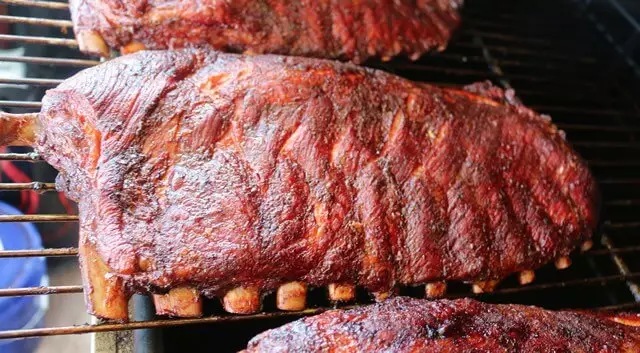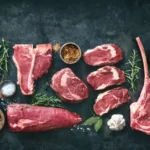The term “rack of ribs” is ubiquitous among barbecue lovers and meat enthusiasts. The simple phrase elicits mouthwatering images of juicy, tender ribs perfectly cooked and glazed with a tangy sauce. But have you ever stopped to consider the size of these succulent rib racks?
The size of a rack of ribs isn’t a trivial detail—it directly impacts cooking methods, serving sizes, and even the overall taste and texture of the ribs. It’s a variable that can subtly but significantly influence your culinary experience.
Different species, different rib types, and even different cooking methods can influence the size of a rack of ribs. A deeper knowledge of this topic will not only enhance your cooking skills but will also boost your understanding of this popular food item.
Anatomy of a Rack of Ribs
Introduction to Rib Types
A rack of ribs refers to a portion of the rib section in the carcass of an animal, typically a mammal. The ribs protect the vital organs in the chest cavity, and the attached muscle and fat make them a prized culinary item. There are various types of ribs depending on the animal species and the specific part of the rib section.
Relation between Species and Rib Size
The species of the animal directly influences the size of a rack of ribs. The ribs of larger mammals like cows are significantly larger than those of smaller animals like lamb and chicken.
Evaluating Rib Rack Sizes
Rib Size Comparison across Species
In general, the size of a rack of ribs varies from species to species. Beef ribs are the largest, often measuring up to 18 inches long. Lamb ribs are considerably smaller, typically around 6-8 inches long, while chicken ribs are the smallest, measuring just 3-5 inches.
Factors Influencing Rib Size
Several factors can influence the size of a rib rack beyond species. These include the animal’s age, diet, breed, and overall health. Moreover, the specific part of the rib section—whether it’s the larger, meatier spare ribs or the smaller, leaner baby back ribs—also affects the size.
Counting the Ribs: How Many in a Rack?
A full rack typically includes all the ribs from one side of the animal. In cows and sheep, this means around 13 ribs, while chickens have fewer ribs, usually about 10.
Rib Rack Sizes: Beef
Beef ribs are among the most popular and flavorful cuts of meat used in cooking and barbecuing. Originating from a part of the cow that provides a perfect mix of meat, fat, and bone, beef ribs are coveted for their rich, hearty flavor. Let’s dive deeper into the world of beef ribs.
Overview of Beef Ribs
Beef ribs come from two primary sections of the cow: the rib section, which yields back ribs, and the lower belly or plate section, which yields short ribs. The specific part of the cow from which the ribs are cut significantly impacts their size, taste, and texture.
Back Ribs
Back ribs are derived from the upper rib section of the cow, specifically between the loin and the chuck. A typical rack of back ribs consists of at least seven ribs, although this can vary. Back ribs are known for their meaty sections between the bones and smaller amounts of meat covering the bones.
Short Ribs
Short ribs are cut from the lower section, specifically the plate cut. Short ribs are thicker, meatier, and weightier compared to back ribs, and are known for their rich marbling and deep flavor.
Average Size of a Beef Rib Rack
Beef ribs are often the largest ribs you’ll encounter in the culinary world. A full rack of beef back ribs typically includes 5-7 ribs and can measure anywhere from 8 to 18 inches long, depending on the size of the cow and the butcher’s cut. However, it’s not uncommon to find beef rib racks sold in smaller portions due to their large size.
Factors Influencing Beef Rib Rack Size
The size of a beef rib rack is influenced by several factors:
Age and Breed of the Cow
Younger cows, often referred to as veal, tend to have smaller ribs. On the other hand, certain breeds of cows are larger and thus have larger ribs.
Diet and Rearing
Grass-fed cows often produce meat with a different texture and marbling than grain-fed cows, which can influence the size of the ribs.
Butcher’s Cut
The way a butcher cuts the rib rack can also significantly impact its size. For example, “shiners” are cut so that more of the bone is exposed, resulting in smaller but often cheaper ribs.
Rib Rack Sizes: Lamb
Lamb ribs are known for their delicate flavor and tender meat. They’re smaller than beef ribs, which makes them easier to handle and quicker to cook. Here’s what you need to know about lamb rib sizes.
Introduction to Lamb Ribs
Lamb ribs come from the rib and loin sections of the lamb. They are typically sold as “rack of lamb” and are one of the most expensive cuts of lamb due to their high demand and limited quantity.
Lamb Rib Rack
A rack of lamb usually includes 8 ribs. They are cut from the upper part of the rib cage and can be sold as a full rack, or cut into smaller sections.
Lamb Spare Ribs
Lamb spare ribs come from the belly side of the rib cage and are smaller, tougher, but flavorful. They are often sold as individual ribs or in small racks.
Average Size of a Lamb Rib Rack
A full rack of lamb ribs usually measures about 6-8 inches in length, making it significantly smaller than a rack of beef ribs.
Elements Influencing Lamb Rib Rack Size
Several factors can influence the size of a lamb rib rack:
Age of the Lamb
Younger lambs, often referred to as “spring lambs,” typically have smaller, more tender ribs compared to older lambs.
Breed of the Lamb
Certain breeds of sheep are naturally larger or smaller, which directly influences the size of their rib racks.
Butcher’s Cut
As with beef ribs, the way the ribs are cut by the butcher can significantly impact the size of the lamb rib rack.
Rib Rack Sizes: Chicken
While chicken ribs are not as common as beef or lamb ribs, they can still be a tasty addition to a meal. Let’s examine the size of chicken ribs.
Brief on Chicken Ribs
Chicken ribs are part of the chicken’s rib cage. Unlike beef and lamb ribs, they are not usually cooked separately but are often left attached when cooking whole chicken or chicken quarters.
Average Size of a Chicken Rib Rack
Due to the small size of chickens compared to cows or sheep, chicken ribs are much smaller, typically about 3-5 inches long.
Factors Determining Chicken Rib Rack Size
As with other types of ribs, several factors can influence the size of chicken ribs:
Age and Breed of the Chicken
Older chickens often have larger ribs, and certain chicken breeds are naturally larger than others.
Diet and Rearing
The diet of the chicken and the conditions in which it was reared can influence the size of its ribs. For example, free-range chickens often develop differently than those raised in confinement.
Butcher’s Cut
The way the chicken is butchered can also impact the size of the ribs, although this is less common than with beef or lamb ribs.
The Impact of Cooking Methods on Rib Size
Grilling and Rib Size
Grilling is a popular method for cooking ribs. The high heat can cause the ribs to shrink slightly, so consider this when planning your servings.
Oven Baking and Rib Size
Oven baking, particularly at low temperatures for extended periods, can also result in slight shrinkage. However, this method often leads to incredibly tender, fall-off-the-bone ribs.
Slow Cooking and Rib Size
Slow cooking is another method that can cause ribs to shrink a bit. However, the gradual, low-heat cooking process helps the ribs retain moisture, leading to succulent, flavorful meat.
Purchasing Ribs: Size Considerations
Size and Serving Proportions
When buying ribs, consider the number of servings you need. A full rack of beef or lamb ribs typically serves 2-3 people, while a chicken rib rack is usually enough for one serving.
Evaluating Quality alongside Size
While size is a significant factor, it’s equally essential to consider the quality of the meat. Look for ribs with a good balance of meat and fat for the most flavorful and juicy result.
Tips for Buying Ribs
When buying ribs, don’t just focus on the size. Also, consider the color, smell, and marbling of the meat. These factors can give you a better idea of the meat’s freshness and quality.
Frequently Asked Questions
Why is knowing the size of a rib rack important?
Knowing the size of a rib rack is crucial as it affects the cooking method, cooking time, serving size, and even the flavor and texture of the ribs.
Do all racks of ribs from the same animal have the same size?
No, the size of a rib rack can vary based on the specific part of the rib section, the animal’s age, diet, breed, and overall health.
Does the cooking method affect the size of a rib rack?
Yes, cooking methods like grilling, oven baking, and slow cooking can cause ribs to shrink slightly due to moisture loss and fat rendering.
Concluding Remarks
The size of a rack of ribs is an often-overlooked yet essential factor in the culinary world. This seemingly trivial detail can influence the method and duration of cooking, the number of servings, and ultimately, the taste and texture of the ribs.
Recognizing the impact of factors like species, age, diet, and cooking methods on the size of a rack of ribs enriches our understanding of this much-loved food item. So the next time you prepare or savor a delicious rack of ribs, you’ll be more informed about what lies beneath the enticing flavors. After all, knowledge, like a perfectly cooked rib, is something to savor.







